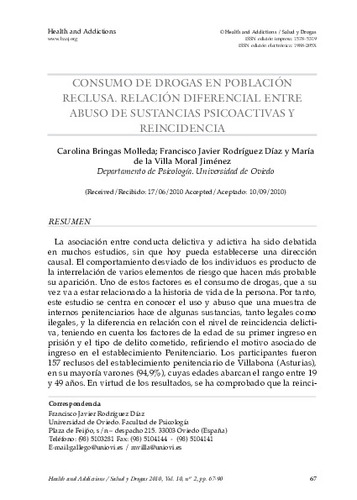Consumo de drogas en población reclusa. Relación diferencial entre abuso de sustancias psicoactivas y reincidencia
Autor(es) y otros:
Palabra(s) clave:
Drogas
Reincidencia
Conducta Delictiva
Internos Penitenciarios
Drugs
Repetition
Criminal Conduct
Penitentiary Boarders
Fecha de publicación:
Editorial:
Instituto de Investigación en Drogodependencias (INID) de Universidad Miguel Hernández
Citación:
Descripción física:
Resumen:
La asociación entre conducta delictiva y adictiva ha sido debatida en muchos estudios, sin que hoy pueda establecerse una dirección causal. El comportamiento desviado de los individuos es producto de la interrelación de varios elementos de riesgo que hacen más probable su aparición. Uno de estos factores es el consumo de drogas, que a su vez va a estar relacionado a la historia de vida de la persona. Por tanto, este estudio se centra en conocer el uso y abuso que una muestra de internos penitenciarios hace de algunas sustancias, tanto legales como ilegales, y la diferencia en relación con el nivel de reincidencia delictiva,teniendo en cuenta los factores de la edad de su primer ingreso en prisión y el tipo de delito cometido, refiriendo el motivo asociado de ingreso en el establecimiento Penitenciario. Los participantes fueron 157 reclusos del establecimiento penitenciario de Villabona (Asturias), en su mayoría varones (94,9%), cuyas edades abarcan el rango entre 19 y 49 años. En virtud de los resultados, se ha comprobado que la reincidencia se asocia positivamente con el consumo de heroína en aquellos delitos relacionados con la salud pública y la propiedad, siendo en este último significativo los ingresos en el Establecimiento Penitenciario a una edad más temprana. Se discuten las implicaciones de los resultados para lograr una adaptación competente buscando una reducción de la actividad delictiva y su reincidencia.
La asociación entre conducta delictiva y adictiva ha sido debatida en muchos estudios, sin que hoy pueda establecerse una dirección causal. El comportamiento desviado de los individuos es producto de la interrelación de varios elementos de riesgo que hacen más probable su aparición. Uno de estos factores es el consumo de drogas, que a su vez va a estar relacionado a la historia de vida de la persona. Por tanto, este estudio se centra en conocer el uso y abuso que una muestra de internos penitenciarios hace de algunas sustancias, tanto legales como ilegales, y la diferencia en relación con el nivel de reincidencia delictiva,teniendo en cuenta los factores de la edad de su primer ingreso en prisión y el tipo de delito cometido, refiriendo el motivo asociado de ingreso en el establecimiento Penitenciario. Los participantes fueron 157 reclusos del establecimiento penitenciario de Villabona (Asturias), en su mayoría varones (94,9%), cuyas edades abarcan el rango entre 19 y 49 años. En virtud de los resultados, se ha comprobado que la reincidencia se asocia positivamente con el consumo de heroína en aquellos delitos relacionados con la salud pública y la propiedad, siendo en este último significativo los ingresos en el Establecimiento Penitenciario a una edad más temprana. Se discuten las implicaciones de los resultados para lograr una adaptación competente buscando una reducción de la actividad delictiva y su reincidencia.
The association between criminal and addictive conduct has been debated in many studies, without today a causal direction could be established. The behavior turned aside from the individuals is a product of the interrelationship of several elements of risk that make his appearance more probable. One of these factors is the consumption of drugs, which in turn is going to be related to the history of life of the person. Therefore, this study centres on knowing the use and abuse that a sample of penitentiary boarders does of some substances, both legal and illegal, and the difference in relation with the level of criminal repetition, having in it counts the factors of the age of his first revenue in prison and the type of committed crime, indicating the associate motive of revenue in the Penitentiary establishment. The participants were 157 prisoners of Villabona’s penitentiary establishment (Asturias), in the main males (94,9 %), whose ages include the range between 19 and 49 years. By virtue of the results, there has been verified that the repetition associates positively with the heroine’s consumption in those crimes related to the public health and the property, being in the latter significantly the income in the Penitentiary Establishment to an earlier age. The implications of the results are discussed to achieve a competent adjustment looking for a reduction of the criminal activity and his repetition.
The association between criminal and addictive conduct has been debated in many studies, without today a causal direction could be established. The behavior turned aside from the individuals is a product of the interrelationship of several elements of risk that make his appearance more probable. One of these factors is the consumption of drugs, which in turn is going to be related to the history of life of the person. Therefore, this study centres on knowing the use and abuse that a sample of penitentiary boarders does of some substances, both legal and illegal, and the difference in relation with the level of criminal repetition, having in it counts the factors of the age of his first revenue in prison and the type of committed crime, indicating the associate motive of revenue in the Penitentiary establishment. The participants were 157 prisoners of Villabona’s penitentiary establishment (Asturias), in the main males (94,9 %), whose ages include the range between 19 and 49 years. By virtue of the results, there has been verified that the repetition associates positively with the heroine’s consumption in those crimes related to the public health and the property, being in the latter significantly the income in the Penitentiary Establishment to an earlier age. The implications of the results are discussed to achieve a competent adjustment looking for a reduction of the criminal activity and his repetition.
Colecciones
- Artículos [37544]
- Psicología [1481]
Ficheros en el ítem




